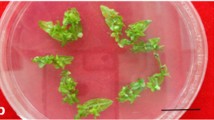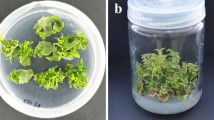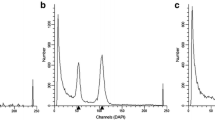Abstract
Tetraploids plants of Anthurium andraeanum “Arizona” were successfully induced after treating diploid tissue masses with colchicine. Masses originating from diploid aerial roots were treated with colchicine at three different concentrations (i.e., 0.1, 0.2, 0.3%) for about 3, 5 and 7 h, and then were transferred into Murashige and Skoog medium containing 3 mg/l BAP + 0.2 mg/l 2,4-D. After 60 days, the survival rate and numbers of regenerative shoots were scored. The high concentration and longer duration sharply reduced survival rate. In contrast, the regeneration of plantlets was not noticeably affected by colchicine. Tetraploid plants were obtained in all treatments, but the percentage of induced tetraploids ranged from 0.2 to 7.6%. The best induction was obtained with a 5-h, treatment with 0.3% colchicine. The stomatal size of tetraploid plants was larger than in diploid plants; however, the stomatal density was lower than in diploid plants. Tetraploid plants possessed stronger petioles, thicker and deeper green leaves, and thicker and longer lived spathes in comparison with diploid plants. Abnormal spathes, such as double spathes or those lacking pedicels, were observed in tetraploid plants. Tetraploid plantlets could be regenerated via aerial roots; this technique could be applied to tetraploid plant propagation.






Similar content being viewed by others
Abbreviations
- BAP:
-
6-Benzylaminopurine
- 2,4-D:
-
2,4-dichlorophenoxyacetic acid
- NAA:
-
1-Naphtaleneacetic acid
- MS:
-
Murashige and Skoog (1962)
- PI:
-
Propidium iodide
- WPB:
-
Woody plant buffer
References
Adaniya S, Shira D (2001) In vitro induction of tetraploid ginger (Zingiber officinalis Roscoe) and it’s pollen fertility and germinability. Sci Hortic 88:277–287. doi:10.1016/S0304-4238(00)00212-0
Barnabas B, Obert B, Kovas G (1999) Colchicine an efficient genome doubling agent for maize (Zea mays L.) microspores cultured in anthero. Plant Cell Rep 18:858–862. doi:10.1007/s002990100364
Carvalho JFR, Carvalho CR, Otoni WC (2005) In vitro induction of polyploidy in annatto (Bixa orellana). Plant Cell Tissue Organ Cult 80:69–75. doi:10.1007/s11240-004-8833-5
Chakraborti SP, Vijayan K, Roy B, Qadri SMH (1998) In vitro induction of tetraploidy in mulberry (Morus alba L.). Plant Cell Rep 17:799–803. doi:10.1016/S0304-4238(00)00212-0
Chavez DJ, Lyrene PM (2009) Production and Identification of Colchicine-derived tetraploid Vaccinium darrowii and its use in breeding. J Am Soc Hort Sci 134:356–363
Cohen D, Yao J (1996) In vitro chromosome doubling of nine Zantedeschia cultivars. Plant Cell Tissue Organ Cult 47:43–49. doi:10.1007/BF02318964
Dhooghe E, Van Labeke MC (2007) In vitro propagation of Helleborus species. Plant Cell Tissue Organ Cult 91:175–177. doi:10.1007/s11240-007-9280-x
Dhooghe E, Denis S, Eeckhaut T, Reheul D, Van Labeke MC (2009a) In vitro induction of tetraploids in ornamental Ranunculus. Euphytica 168:33–40. doi:10.1007/s10681-008-9876-1
Dhooghe E, Grunewald W, Leen L, Van Labeke MC (2009b) In vitro polyploidyisation of Helleborus species. Euphytica 65:89–95. doi:10.1007/s10681-008-9763-9
Eeckhaut TGR, Werbrouck SPO, LeusL WH, Van Bockstaele EJ, Debergh PC (2004) Chemically induced polyploidizationin Spathiphyllum wallisii Regel through somatic embryogenesis. Plant Cell Tissue Organ Cult 78:241–246. doi:10.1023/B:TICU.0000025659.19232.04
Esnard J, Ferwerda F, Rivera-Amador E, Hepperly P (1993) Induction of tetraploidy in the tanier cultivar ‘Inglesa’ (Xanthosoma sagittifolium (L.) Schott). Plant Breed 111:335–338. doi:10.1111/j.1439-0523.1993.tb00651.x
Gu XF, Yang AF, Meng H, Zhang JR (2005) In vitro induction of tetraploid plants from diploid Zizyphus jujuba Mill.cv. Zhanhua. Plant Cell Rep 24:671–676. doi:10.1007/s00299-005-0017-1
Hamidah M, Karim AGA, Debergh P (1997) Somatic embryogenesis and plant regeneration in Anthurium scherzerianum. Plant Cell Tissue Organ Cult 48:189–193. doi:10.1023/A:1005834131478
Hamill SD, Smith MK, Dodd W (1992) In vitro induction of banana autotetraploidy by colchicine treatment of micropropagated diploids. Aust J Bot 40:887–896. doi:10.1071/BT9920887
Kadota M, Niimi Y (2002) In vitro induction of tetraploid plants from a diploid Japanese pear cultivar (Pyruspyri-folia N.cv.Hosui). Plant Cell Rep 21:282–286. doi:10.1007/s00299-002-0509-1
Kuehnle AR, Sugii N (1991) Callus induction and plantlet regeneration in tissue cultures of Hawaiian Anthuriums. HortScience 26:919–921
Kunisaki JT (1980) In vitro propagation of Anthurium andreanum Lind. HortScience 15:508–509
Li MX, Chen RY (1985) A suggestion on the standarization of karyotype analysis in plants. J Wuhan Bot Res 3(4):297–302 (in Chinese)
Liu G, Li Z, Bao M (2007) Colchicine-induced chromosome doubling in Platanus acerifolia and its effect on plant morphology. Euphytica 157:145–154. doi:10.1007/s10681-007-9406-6
Loureiro J, Rodriguez E, Dolezel J, Santos C (2007) Two new nuclear isolation buffers for plant DNA flow cytometry: a test with 37 species. Ann Bot 100(4):875–888
Martin KP, Joseph D, Madassery J, Philip VJ (2003) Direct shoot regeneration from lamina explants of two commercial cut flower cultivars of Anthurium andreanum Hort. In Vitro Cell Dev Biol Plant 39:500–504. doi:10.1079/IVP2003460
Murashige T, Skoog F (1962) A revised medium for rapid growth and bioassays with tobacco tissue culture. Physiol Plant 15:473–497. doi:10.1111/j.1399-3054.1962.tb08052.x
Petersen KK, Hagberg P, Kristiansen K (2003) Colchicine and oryzalin mediated chromosome doubling in different genotypes of Miscanthus sinensis. Plant Cell Tissue Organ Cult 73:137–146. doi:10.1023/A:1022854303371
Roy A, Leggett G, Koutoulis A (2001) In vitro tetraploid induction and generation of tetraploids from mixoploids in hop (Humulus lupulus L). Plant Cell Rep 20(6):489–495
Shao J, Chen C, Deng X (2003) In vitro induction of tetraploid in pomegranate (Punica granatum). Plant Cell Tissue Organ Cult 75:241–246. doi:10.1023/A:1025871810813
Sheffer RD, Croat TB (1983) Chromosome numbers in the genus Anthurium (Araceae) II. Am J Bot 70:858–871
Sheffer RD, Kamemoto H (1976) Chromosome numbers in the genus Anthurium. Am J Bot 63:74–81
Sikdar AK, Jolly MS (1994) Induced polyploidy in mulberry (Morus spp.): induction of tetraploids. Sericologia 34:105–116
Teng WL (1997) Regeneration of Anthurium adventitious shoots using liquid or raft culture. Plant Cell Tiss Organ Cult 49:153–156. doi:10.1023/A:1005845931345
Thao NTP, Ureshino K, Miyajima I, Ozaki Y, Okubo H (2003) Induction of tetraploids in ornamental Alocasia through colchicine and oryzalin treatments. Plant Cell Tissue Organ Cult 72:19–25. doi:10.1023/A:1021292928295
Van Duren M, Mopurgo R, Dolezel J, Afza R (1996) Induction and verification of autotetraploids in diploid banana (Musaacuminata) by in vitro techniques. Euphytica 88:25–34. doi:10.1007/BF00029262
Vanzie-Canton SD, Leonhardt KW (2009) In vivo polyploidization of Zamioculcas Zamiifolia. Acta Hort (ISHS) 813:531–538. http://www.actahort.org/books/813/813_72.htm
Wang GL, Chen C, Li ZX, Li W, Lin XJ (2005) Establishment of rapid propagation system of aerial root segments of Anthurium andraeanum. Plant Physiol Commun 41:1–5 (in Chinese)
Wang GL, Chen C, Li W, Li YM (2006) Cytological study on callus of leaf and reproduction block mass of aerial root in Anthurium andraeanum. Acta Hortic Sin 33:59–587 (in Chinese)
Yao J, Cohen D (1996) Production of triploid Zantedeschia hybrids using embryo rescue. New Zeal J Crop Hort 24:297–301. doi:10.1080/01140671.1996.9513965
Zhang ZH, Dai HY, Ae MX, Liu X (2008) In vitro induction of tetraploids in Phlox subulata L. Euphytica 159:59–65. doi:10.1007/s10681-007-9457-8
Author information
Authors and Affiliations
Corresponding author
Rights and permissions
About this article
Cite this article
Chen, C., Hou, X., Zhang, H. et al. Induction of Anthurium andraeanum “Arizona” tetraploid by colchicine in vitro. Euphytica 181, 137–145 (2011). https://doi.org/10.1007/s10681-010-0344-3
Received:
Accepted:
Published:
Issue Date:
DOI: https://doi.org/10.1007/s10681-010-0344-3




